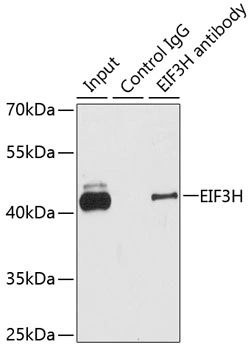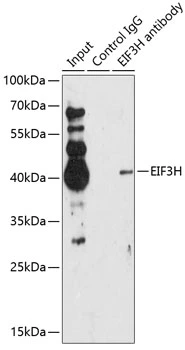eIF3H / EIF3S3 antibody [GT2712]
GTX633630
ApplicationsWestern Blot
Product group Antibodies
TargetEIF3H
Overview
- SupplierGeneTex
- Product NameeIF3H / EIF3S3 antibody [GT2712]
- Delivery Days Customer9
- Application Supplier NoteWB: 1:500-1:3000. *Optimal dilutions/concentrations should be determined by the researcher.Not tested in other applications.
- ApplicationsWestern Blot
- CertificationResearch Use Only
- ClonalityMonoclonal
- Clone IDGT2712
- Concentration1 mg/ml
- ConjugateUnconjugated
- Gene ID8667
- Target nameEIF3H
- Target descriptioneukaryotic translation initiation factor 3 subunit H
- Target synonymsEIF3S3, eIF3-gamma, eIF3-p40, eukaryotic translation initiation factor 3 subunit H, eIF-3-gamma, eIF3 p40 subunit, eukaryotic translation initiation factor 3 subunit 3, eukaryotic translation initiation factor 3, subunit 2 (beta, 36kD), eukaryotic translation initiation factor 3, subunit 3 (gamma, 40kD), eukaryotic translation initiation factor 3, subunit 3 gamma, 40kDa
- HostMouse
- IsotypeIgG1
- Protein IDO15372
- Protein NameEukaryotic translation initiation factor 3 subunit H
- Scientific DescriptionComponent of the eukaryotic translation initiation factor 3 (eIF-3) complex, which is required for several steps in the initiation of protein synthesis (PubMed:17581632, PubMed:25849773, PubMed:27462815). The eIF-3 complex associates with the 40S ribosome and facilitates the recruitment of eIF-1, eIF-1A, eIF-2:GTP:methionyl-tRNAi and eIF-5 to form the 43S pre-initiation complex (43S PIC). The eIF-3 complex stimulates mRNA recruitment to the 43S PIC and scanning of the mRNA for AUG recognition. The eIF-3 complex is also required for disassembly and recycling of post-termination ribosomal complexes and subsequently prevents premature joining of the 40S and 60S ribosomal subunits prior to initiation (PubMed:17581632). The eIF-3 complex specifically targets and initiates translation of a subset of mRNAs involved in cell proliferation, including cell cycling, differentiation and apoptosis, and uses different modes of RNA stem-loop binding to exert either translational activation or repression (PubMed:25849773).
- Storage Instruction-20°C or -80°C,2°C to 8°C
- UNSPSC12352203





